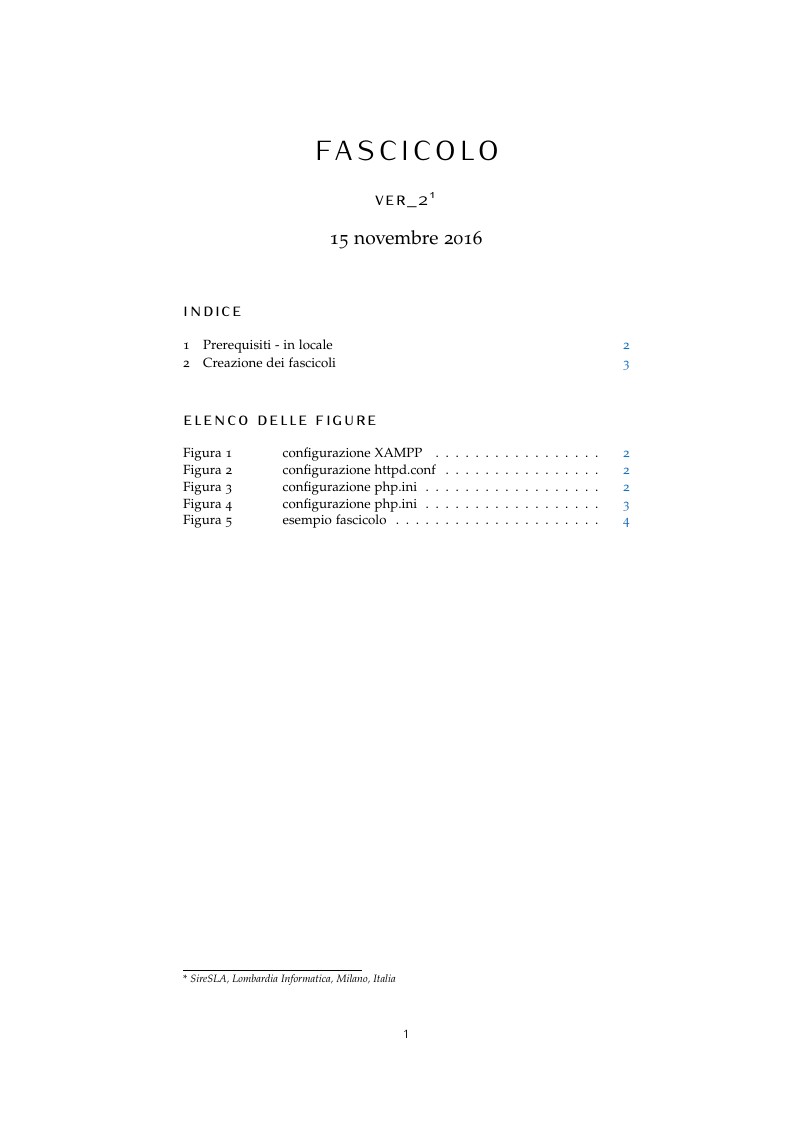
Installation instructions for XAMPP

%%%%%%%%%%%%%%%%%%%%%%%%%%%%%%%%%%%%%%%%%
% Arsclassica Article
% LaTeX Template
% Version 1.1 (05/01/2015)
%
% This template has been downloaded from:
% http://www.LaTeXTemplates.com
%
% Original author: Adriano Palombo
%
%
%%%%%%%%%%%%%%%%%%%%%%%%%%%%%%%%%%%%%%%%%
%----------------------------------------------------------------------------------------
% PACKAGES AND OTHER DOCUMENT CONFIGURATIONS
%----------------------------------------------------------------------------------------
\documentclass[
10pt, % Main document font size
a4paper, % Paper type, use 'letterpaper' for US Letter paper
oneside, % One page layout (no page indentation)
%twoside, % Two page layout (page indentation for binding and different headers)
headinclude,footinclude, % Extra spacing for the header and footer
BCOR5mm, % Binding correction
]{scrartcl}
\input{structure.tex} % Include the structure.tex file which specified the document structure and layout
\hyphenation{Fortran hy-phen-ation} % Specify custom hyphenation points in words with dashes where you would like hyphenation to occur, or alternatively, don't put any dashes in a word to stop hyphenation altogether
%----------------------------------------------------------------------------------------
% TITLE AND AUTHOR(S)
%----------------------------------------------------------------------------------------
\title{\normalfont\spacedallcaps{Fascicolo}} % The article title
\author{\spacedlowsmallcaps{ver\_2\textsuperscript{1}}} % The article author(s) - author affiliations need to be specified in the AUTHOR AFFILIATIONS block
%\date{} % An optional date to appear under the author(s)
%----------------------------------------------------------------------------------------
\begin{document}
%----------------------------------------------------------------------------------------
% HEADERS
%----------------------------------------------------------------------------------------
\renewcommand{\sectionmark}[1]{\markright{\spacedlowsmallcaps{#1}}} % The header for all pages (oneside) or for even pages (twoside)
%\renewcommand{\subsectionmark}[1]{\markright{\thesubsection~#1}} % Uncomment when using the twoside option - this modifies the header on odd pages
\lehead{\mbox{\llap{\small\thepage\kern1em\color{halfgray} \vline}\color{halfgray}\hspace{0.5em}\rightmark\hfil}} % The header style
\pagestyle{scrheadings} % Enable the headers specified in this block
%----------------------------------------------------------------------------------------
% TABLE OF CONTENTS & LISTS OF FIGURES AND TABLES
%----------------------------------------------------------------------------------------
\maketitle % Print the title/author/date block
\setcounter{tocdepth}{2} % Set the depth of the table of contents to show sections and subsections only
\tableofcontents % Print the table of contents
\listoffigures % Print the list of figures
%\listoftables % Print the list of tables
%----------------------------------------------------------------------------------------
% AUTHOR AFFILIATIONS
%----------------------------------------------------------------------------------------
{\let\thefootnote\relax\footnotetext{* \textit{SireSLA, Lombardia Informatica, Milano, Italia}}}
%{\let\thefootnote\relax\footnotetext{\textsuperscript{1} \textit{Department of Chemistry, University of Examples, London, United Kingdom}}}
%----------------------------------------------------------------------------------------
\newpage % Start the article content on the second page, remove this if you have a longer abstract that goes onto the second page
%----------------------------------------------------------------------------------------
% INTRODUCTION
%----------------------------------------------------------------------------------------
\section{Prerequisiti - in locale}
\begin{enumerate}
\item Scaricare XAMPP da \url{https://www.apachefriends.org/it/index.html} e seguire la procedura standard di installazione di un qualsiasi programma per windows.
\item Lanciare l’eseguibile di XAMPP “xampp-control.exe” che si trova in C:$\setminus$xampp
\begin{figure}[h]
\centering\includegraphics[scale=0.5]{xampp}
\caption{configurazione XAMPP}
\end{figure}
\item Qualora non fosse aperta la porta 80 cliccare su Config (di Apache) e aprire il file di “testo” httpd.conf e configurare la porta 80 come segue:
\begin{figure}[h]
\centering\includegraphics[scale=0.5]{httpd_conf80}
\caption{configurazione httpd.conf}
\end{figure}
\item aprire il file di “testo” php.ini e configurare e de commentare la riga 1008 come segue:
\begin{figure}[h]
\centering\includegraphics[scale=0.5]{1008}
\caption{configurazione php.ini}
\end{figure}
\item aprire il file di “testo” php.ini e settare il timeout di risposta a 60 sec come segue:
\begin{figure}[h]
\centering\includegraphics[scale=0.5]{60sec}
\caption{configurazione php.ini}
\end{figure}
\item (chiudere XAMPP e riavviarlo)
\item Copiare la cartella ”Fascicolo” che al momento è sotto la cartella condivisa:\\
C:$\setminus$..$\setminus$A605 - Monitoraggio SLA e Esercizio all'interno di C:$\setminus$xampp$\setminus$htdocs
\end{enumerate}
\section{Creazione dei fascicoli}
\begin{enumerate}
\item Lanciare XAMPP (doppio click su XAMPP “xampp-control.exe” che si trova in C:$\setminus$xampp)
\item Aprire il browser e digitare il seguente path:
\begin{itemize}
\item \url{http://localhost/fascicolo/allSCH_FAS.php} (è un’operazione che richiede circa 3 min)
\begin{itemize}
\item Se l’operazione è andata a buon fine visualizzerete la scritta FINITO
\begin{itemize}
\item Altrimenti fare un refresh della pagina
\end{itemize}
\end{itemize}
In questo modo sarà creata la prima pagina del fascicolo per tutti gli “SCH” e copiate nella cartella: C:$\setminus$xampp$\setminus$htdocs$\setminus$Fascicolo$\setminus$allFAS
\end{itemize}
\item Aprire il browser e digitare il seguente path:
\begin{itemize}
\item \url{http://localhost/fascicolo/allINC_FAS.php}
\begin{itemize}
\item Se l’operazione è andata a buon fine visualizzerete la scritta FINITO
\end{itemize}
In questo modo sarà creata la prima pagina del fascicolo per tutti gli “INC” e copiate nella cartella: C:$\setminus$xampp$\setminus$htdocs$\setminus$Fascicolo$\setminus$allFAS
\end{itemize}
\item Aprire il browser e digitare il seguente path:
\begin{itemize}
\item \url{http://localhost/fascicolo/PDFMerger/mergeAllFascicoli.php} (è un’operazione che richiede circa 5 min)
\begin{itemize}
\item Se l’operazione è andata a buon fine visualizzerete la scritta FINITO
\begin{itemize}
\item Altrimenti fare un refresh della pagina
\end{itemize}
\end{itemize}
In questo modo sarà associata la prima pagina “SCH” o “INC” precedentemente realizzata con gli altri due file pdf di interesse, in modo da avere il fascicolo completo.
I fascicoli realizzati saranno copiati nella cartella: C:$\setminus$xampp$\setminus$htdocs$\setminus$Fascicolo$\setminus$FASCICOLI divisi per FSM$\Rightarrow$SM$\Rightarrow$Fascicolo-SCH-XXX\_XX.pdf
\end{itemize}
\item In ultimo Copiare la cartella C:$\setminus$xampp$\setminus$htdocs$\setminus$Fascicolo$\setminus$FASCICOLI nella cartella condivisa:
C:$\setminus$..$\setminus$A605 - Monitoraggio SLA e Esercizio all'interno di:\\
$\setminus$$\setminus$mega-srv-prod$\setminus$RepositoryFunzione$\setminus$A605 - Monitoraggio SLA e Eser\\cizio$\setminus$FASCICOLO\_STORICO$\setminus$FASCICOLO\_MESE\_ANNO
\end{enumerate}
\begin{figure}[h]
\centering\includegraphics[scale=0.85]{fascicolo}
\caption{esempio fascicolo}
\end{figure}
%----------------------------------------------------------------------------------------
% BIBLIOGRAPHY
%----------------------------------------------------------------------------------------
%\renewcommand{\refname}{\spacedlowsmallcaps{References}} % For modifying the bibliography heading
%\bibliographystyle{unsrt}
%\bibliography{sample.bib} % The file containing the bibliography
%----------------------------------------------------------------------------------------
\end{document}